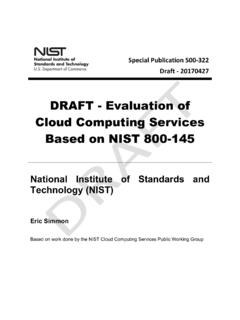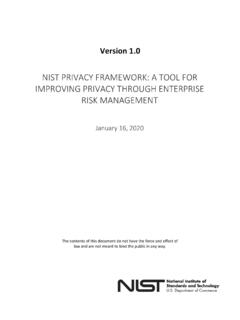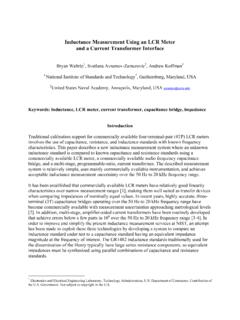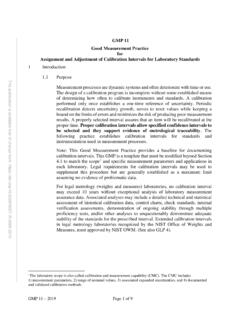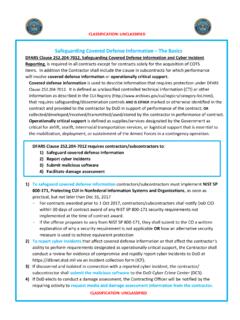Transcription of IEEE-1588 Standard for a Precision Clock ... - NIST
1 IEEE-1588 Standard for a Precision Clock Synchronization Protocol for Networked Measurement and Control Systems-A Tutorial-John EidsonOctober 10, Copyright 2005 Agilent Technologies, overview of the technology and to the Standard -a detailed analysis of the major 1588 interoperability/conformance topicsTutorial on IEEE 1588 October 10, 2005 Page 2 General Overview of the and activities surrounding IEEE to other protocolsTutorial on IEEE 1588 October 10, 2005 Page 3 The Purpose of IEEE 1588 IEEE 1588 is a protocol designed to synchronize real- time clocks in the nodes of a distributed system that communicate using a network. NETWORK Tutorial on IEEE 1588 October 10, 2005 Page 4 The Status of IEEE 1588 Approved by the IEEE-SA Review Committee on September 12, 2002 Published as IEEE 1588-2002 on November 8, 2002 Available from the IEEE Approved as IEC Standard IEC 61588 on May 21, 2004 Products and installations started appearing in late 2003 Conferences on IEEE 1588 held in 2003, 2004, 2005 P1588 committee in process of extending the Standard -target completion in late 2006 Current information may be found at on IEEE 1588 October 10.
2 2005 Page 5 Comparison to Other ProtocolsIEEE-1588 NTPGPSTTPSERCOSS patial extentA few subnetsWide areaWide areaLocal busLocal busCommuni-cationsNetworkInternetSatelli teBus or starBusTarget accuracySub-microsecondFew millisecondsSub-microsecondSub-microseco ndSub-microsecondStyleMaster/slavePeer ensembleClient/serverDistributedMaster/S laveResourcesSmall network message and computation footprintModerate network and computation footprintModerate computation footprintModerateModerateTutorial on IEEE 1588 October 10, 2005 Page 6 Comparison to Other Protocols (continued)IEEE 1588 NTPGPSTTPSERCOSL atency correctionYesYesYesConfiguredNoNoConfigu redYesEvery TDMA cycle, ~msProtocol specifies security No (V2 may include security)YesNoNoAdministrationSelf organizingConfiguredN/AConfiguredHardwar e?For highest accuracyNoRF receiver and processorYesUpdate interval~2 secondsVaries, nominally seconds~1 secondEvery TDMA cycle, ~msTutorial on IEEE 1588 October 10, 2005 Page 7 Comparison to Other Protocols (summary)IEEE 1588: Target is groups of relatively stable components, locally networked (a few subnets), cooperating on a set of well defined : (Network time Protocol, RFC 1305).
3 Target is autonomous systems widely dispersed on the : (Satellite based Global Positioning System of the US Department of Defense): Target is autonomous, widely dispersed ( ), SERCOS (IEC 61491): Target is tightly integrated, usually bus or specialized TDMA network based closed systems. Tutorial on IEEE 1588 October 10, 2005 Page 8 Guide to the Standard -(A detailed analysis of the major clauses of version 1) and goals of the messages and of master clocks machine and messagesTutorial on IEEE 1588 October 10, 2005 Page 9 Objectives of IEEE 1588 Sub-microsecond synchronization of real- time clocks in components of a networked distributed measurement and control system* Intended for relatively localized systems typical of industrial automation and test and measurement environments. * Applicable to local area networks supporting multicast communications (including but not limited to Ethernet)*indicates objectives that may be extended in version 2 Tutorial on IEEE 1588 October 10, 2005 Page 10 Objectives of IEEE 1588 (continued) Simple, administration free installation Support heterogeneous systems of clocks with varying Precision , resolution and stability Minimal resource requirements on networks and host on IEEE 1588 October 10, 2005 Page 11 The IEEE 1588 Standard Defines.
4 Descriptors characterizing a Clock The states of a Clock and the allowed state transitions IEEE 1588 network messages, fields, and semantics Datasets maintained by each Clock Actions and timing for all IEEE 1588 network and internal eventsTutorial on IEEE 1588 October 10, 2005 Page 12 Critical physical specifications A suite of messages for monitoring the system Specifications for an Ethernet based implementation Conformance requirements Implementation suggestionsTutorial on IEEE 1588 October 10, 2005 Page 13 Overview of the IEEE 1588 StandardClausePurposeAnnexPurpose1 ScopeAUser Information2 Standards ReferencesBTime Scales3 DefinitionsCSubdomain Maps4 Notation ConventionDEthernet UDP/IP Implementation5 DatatypesEBibliography6 Protocol Overview7 Protocol8 Message Specifications9 ConformanceTutorial on IEEE 1588 October 10, 2005 Page 14 WARNINGThe IEEE has rather strict rules on interpreting IEEE Standards.
5 No individual or organization can issue official interpretations or provide definitive answers to questions of interpretation. This must be done by an IEEE authorized committee. Even this committee cannot extend, correct, or change the Standard -this must be done by can learn from and share our collective experience. Tutorial on IEEE 1588 October 10, 2005 Page 15 Clause 6: PTP Clock Synchronization ModelQUESTION: How do we take a collection of clocks, message types, Clock properties, networks, etc. and produce a consistent time base in all the participating clocks?MESSAGE TYPESSyncDelay_ReqFollow_UpDelay_RespMan agementCLOCK PROPERTIESUUIDS tratumIdentifierStateVariance ..NETWORK COMMUNICATION FORMS: Ethernet (UDP/IP), DeviceNet, L2 Ethernet, , ..Tutorial on IEEE 1588 October 10, 2005 Page 16 Guide to the Standard -(A detailed analysis of the major clauses) and goals of the messages and of master clocks machine and DTutorial on IEEE 1588 October 10, 2005 Page 17 Clause 6: IEEE 1588 Synchronization BasicsStep 1: Organize the clocks into a master-slave hierarchy(based on observing the Clock property information contained in multicastSync messages)Step 2: Each slave synchronizes to its master (based on Sync, Delay_Req, Follow_Up, and Delay_Resp messages exchanged between master and its slave)Grandmaster Clock This Clock determines the time base for the system Slave to the Grandmaster Clock and Master to its Slave Slave to its Master Tutorial on IEEE 1588 October 10, 2005 Page 18 Clause 6.
6 Synchronization Basics (continued)Master Clock TimeSlave Clock TimeData atSlave ClockFollow_Up messagecontaining value of t1 Delay_Resp messagecontaining value of t4t1t2 Sync messageDelay_Req messaget2t1, t2t3t4t1, t2, t3t1, t2, t3, t4t2mt3mtimeTutorial on IEEE 1588 October 10, 2005 Page 19To synchronize a pair of clocks, First: Send a message, (Sync message), from masterto slaveand measure the apparent time difference between the two clocks. MS_difference = slave s receipt time master s sending time = t2 t1 MS_difference = offset + MS delay (by inspection) For example: MS_difference = slave s receipt time master s sending time 90 minutes = 11:30 10:00 Clause 6: Synchronization Basics (continued) Master Clock : 10:00AM Slave Clock : 11:00AM Offset = 1 hour Sending time : 10:00AM Receipt time : 11:30AM Send message with Propagation time = 30 minutes M S t1 t2 Tutorial on IEEE 1588 October 10, 2005 Page 20 Second: Send a message, (Delay_Req message), from slaveto master and measure the apparent time difference between the two clocks.
7 SM_difference = master s receipt time slave s sending time = t4 t3SM_difference = offset + SM delay (by inspection) For example: SM_difference = master s receipt time slave s sending time 20 minutes = 11:10 11:30 Clause 6: Synchronization Basics (continued) Master Clock : 10:30AM Slave Clock : 11:30AM Offset = 1 hour Receipt time : 11:10AM Sending time : 11:30AM Send message with Propagation time = 40 minutes M S t4 t3 Tutorial on IEEE 1588 October 10, 2005 Page 21 Clause 6: Synchronization Basics (continued)The result is that we have the following two equations:MS_difference = offset + MS delay SM_difference = offset + SM delayWith twomeasured quantities:MS_difference = 90 minutesSM_difference = 20 minutesAnd threeunknowns:offset , MS delay, and SM delayTutorial on IEEE 1588 October 10, 2005 Page 22 Clause 6: Synchronization Basics (continued)Rearranging the two equations:MS_difference = offset + MS delay SM_difference = offset + SM delayWe get:offset = {(MS_difference SM_difference) (MS delay SM delay )}/2MS delay + SM delay = {MS_difference + SM_difference} ASSUME:MS delay = SM delay = one_way_delayThen:offset = {MS_difference SM_difference}/2one_way_delay = {MS_difference + SM_difference}/2 Tutorial on IEEE 1588 October 10, 2005 Page 23 Clause 6: Synchronization Basics (continued)offset = {MS_difference SM_difference}/2one_way_delay = {MS_difference + SM_difference}/2 In our example using the two measured quantities:MS_difference = 90 minutesSM_difference = 20 minutesWe get.
8 Offset = {90 ( 20)}/2 = 55 minutes (not actual 60)one_way_delay = {90 + ( 20 )}/2 = 35 minutes (not 30 or 40)Tutorial on IEEE 1588 October 10, 2005 Page 24 Synchronization Details (clauses 6 & 7) IEEE-1588 CodeNetwork protocol stack & OSPhysical layerSync detector & timestamp generatorMaster Clock messageTimestamp PointTime at which a Sync message passed the Timestamp Point (t1)Tutorial on IEEE 1588 October 10, 2005 Page 25 Synchronization Details (continued) IEEE-1588 CodeNetwork protocol stack & OSPhysical layerSync detector & timestamp generatorSlave Clock messageTimestamp PointTime at which a Sync message passed the Timestamp Point (t2)Tutorial on IEEE 1588 October 10, 2005 Page 26 Synchronization Details (continued) Sync messages: Issued by clocks in the Master state Contain Clock characterization information Contain an estimateof the sending time (~t1) When received by a slave Clock the receipt time is noted Can be distinguished from other legal messages on the network For best accuracy these messages can be easily identified and detected at or near the physical layer and the precise sending (or receipt) time recordedTutorial on IEEE 1588 October 10, 2005 Page 27 Synchronization Details (continued) Follow_Up messages.
9 Issued by clocks in the Master state Always associated with the preceding Sync message Contain the precise sending time = (t1) as measured as close as possible to the physical layer of the network When received by a slave Clock the precise sending time is used in computations rather than the estimated sending time contained in the Sync messageTutorial on IEEE 1588 October 10, 2005 Page 28 Synchronization Details (continued) IEEE-1588 CodeNetwork protocol stack & OSPhysical layerSync detector & timestamp generatorSlave Clock sends: Delay_Req messageTimestamp PointTime at which a Delay_Req message passed the Timestamp Point (t3)Tutorial on IEEE 1588 October 10, 2005 Page 29 Synchronization Details (continued) IEEE-1588 CodeNetwork protocol stack & OSPhysical layerSync detector & timestamp generatorMaster Clock receives: Delay_Req messageMaster Clock sends: Delay_Resp messageTimestamp PointTime at which a Delay_Req message passed the Timestamp Point (t4)Tutorial on IEEE 1588 October 10, 2005 Page 30 Delay_Req messages.
10 Issued by clocks in the Slave state The slave measures and records the sending time (t3) When received by the master Clock the receipt time is noted (t4) Can be distinguished from other legal messages on the network For best accuracy these messages can be easily identified and detected at or near the physical layer and the precise sending (or receipt) time recordedTutorial on IEEE 1588 October 10, 2005 Page 31 Delay_Resp messages: Issued by clocks in the Master state Always associated with a preceding Delay_Req message from a specific slave Clock Contain the receipt time of the associated Delay_Req message (t4) When received by a slave Clock the receipt time is noted and used in conjunction with the sending time of the associated Delay_Req message as part of the latency calculationTutorial on IEEE 1588 October 10, 2005 Page 32 Synchronization computation (in the Slave Clock ).
